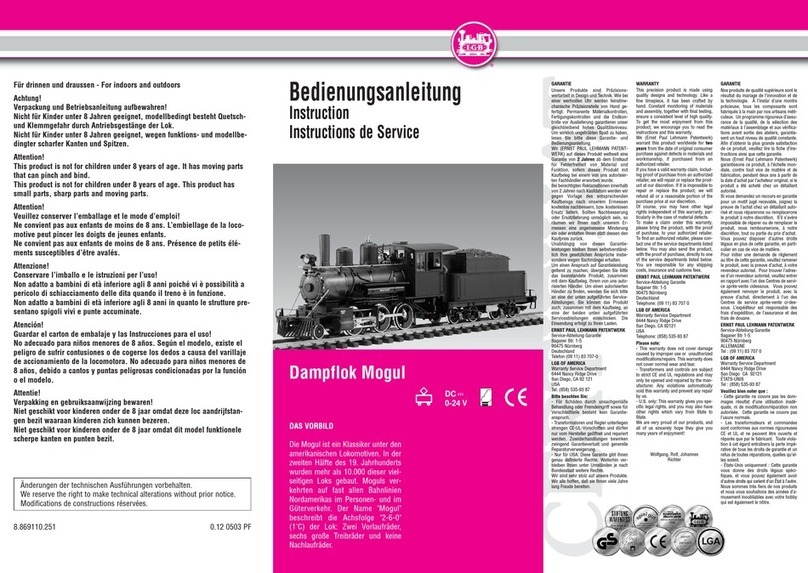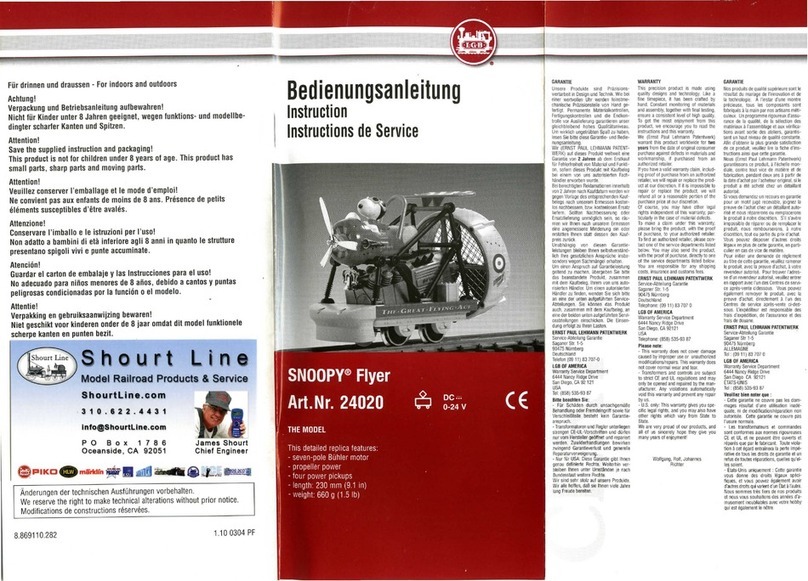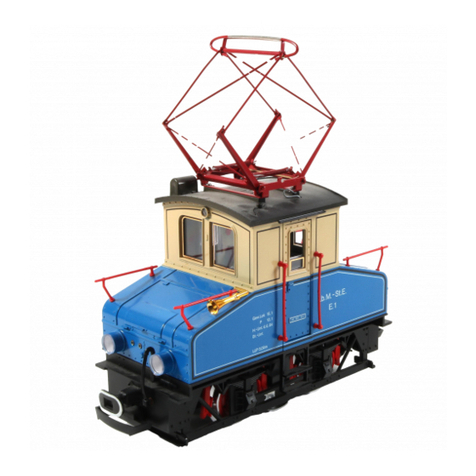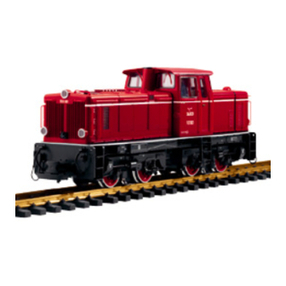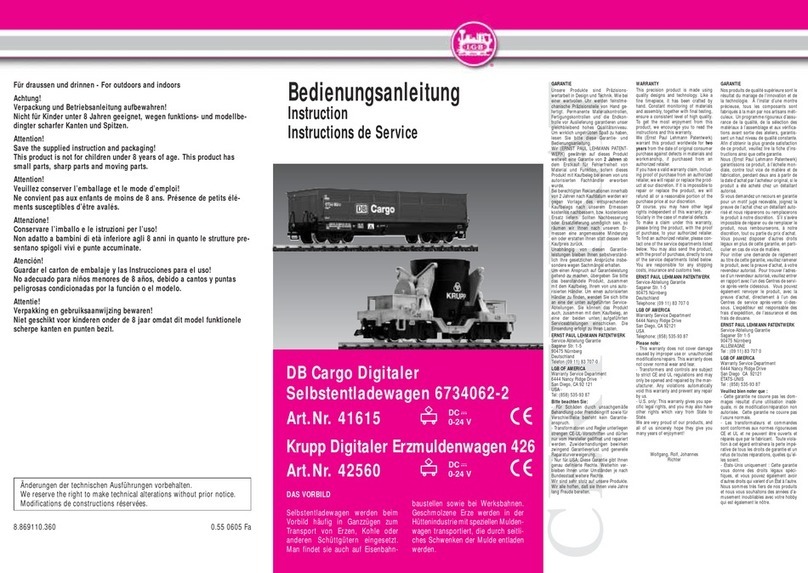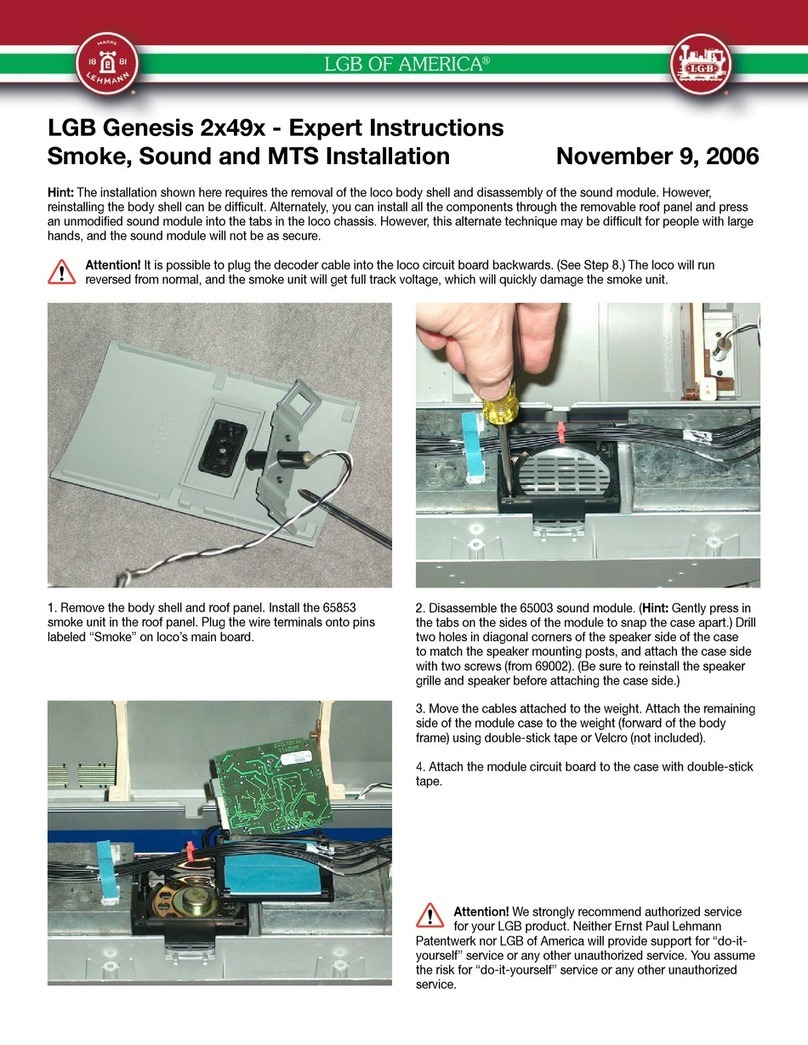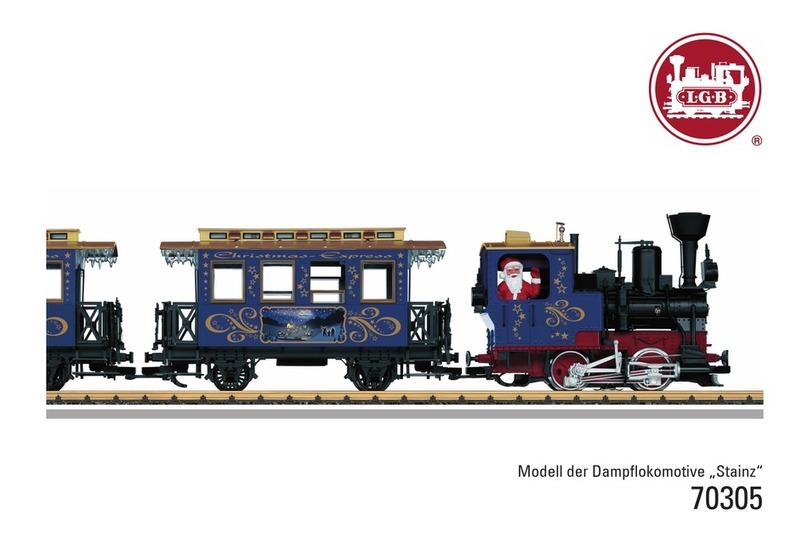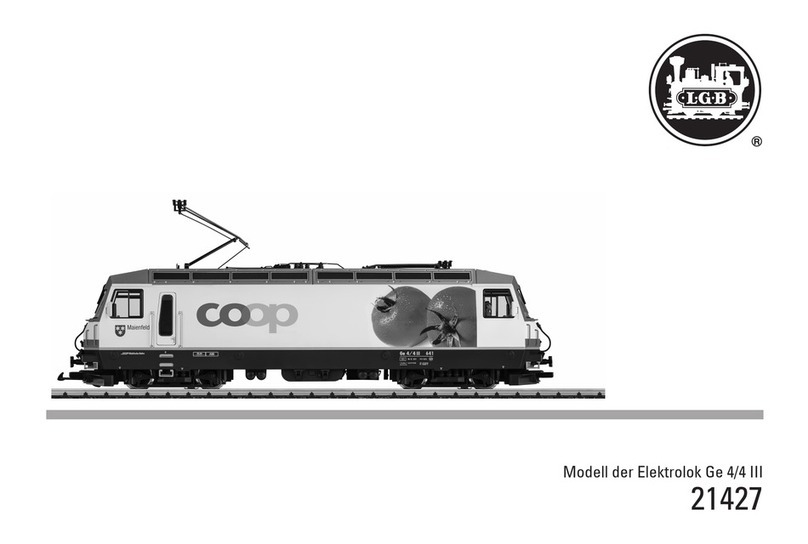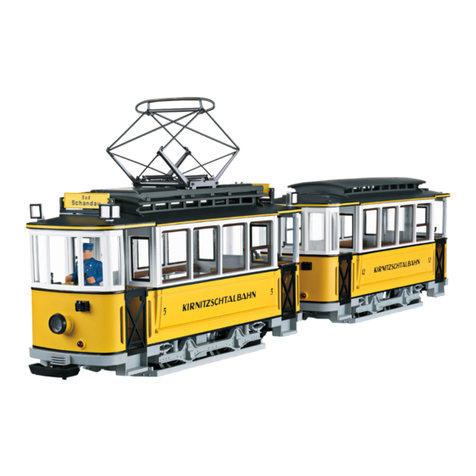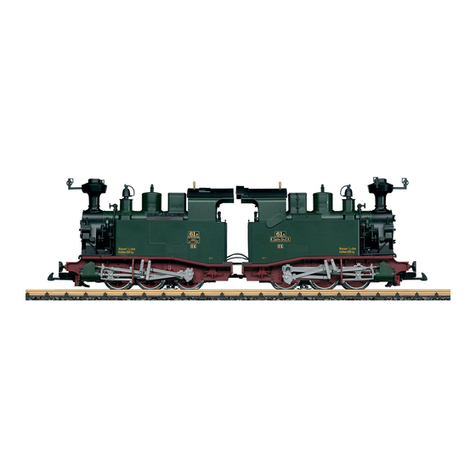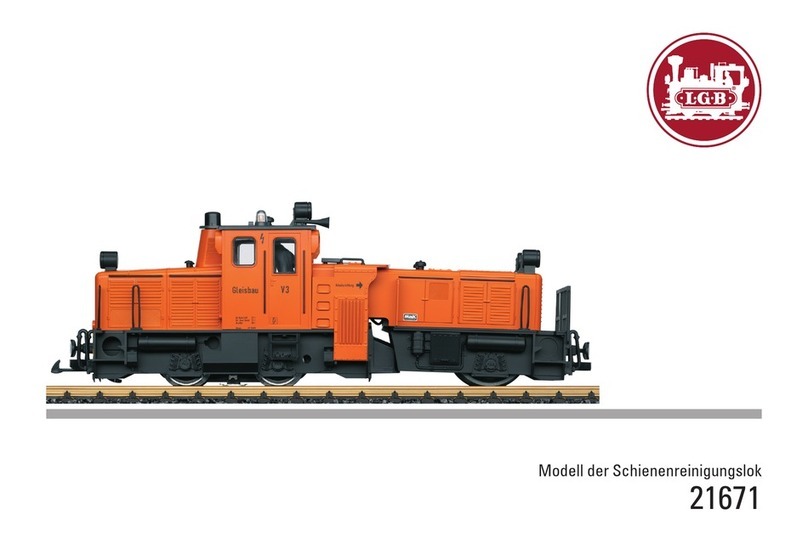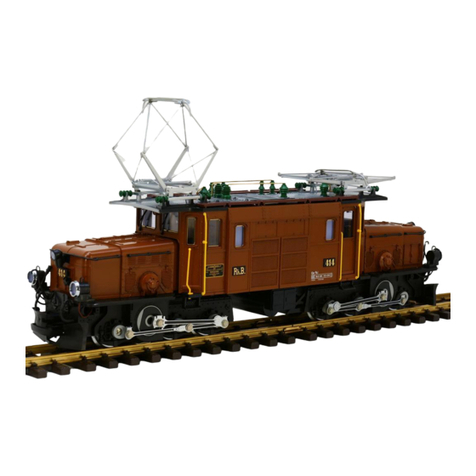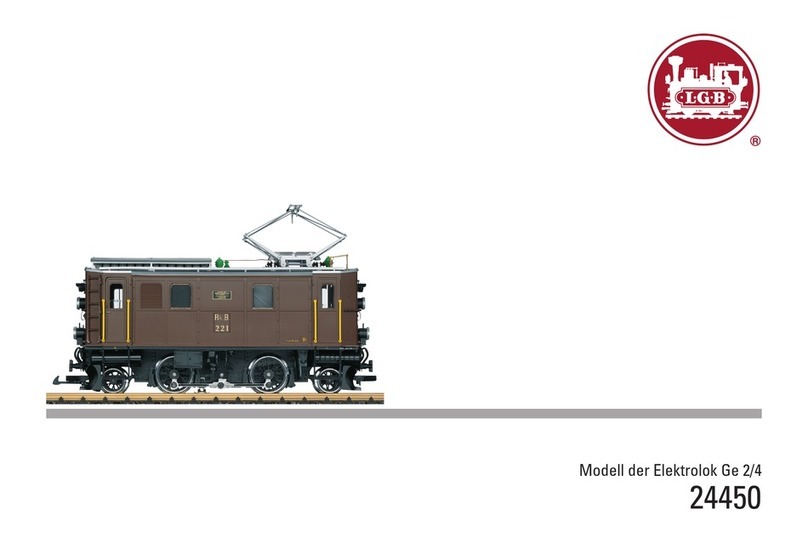4
Sicherheitshinweise
• DasModelldarfnurmiteinemdafürbestimmten
Betriebssystem eingesetzt werden.
• NurSchaltnetzteileundTransformatorenverwenden,
die Ihrer örtlichen Netzspannung entsprechen.
• DasModelldarfnurauseinerLeistungsquelleversorgtwerden.
• BeachtenSieunbedingtdieSicherheitshinweiseinderBedienungsanleitungzu
Ihrem Betriebssystem.
• NichtfürKinderunter15Jahren.
• ACHTUNG!FunktionsbedingtescharfeKantenundSpitzen.
Wichtige Hinweise
• DieBedienungsanleitungistBestandteildesProduktesundmussdeshalbaufbe-
wahrt sowie bei Weitergabe des Produktes mitgegeben werden.
• GewährleistungundGarantiegemäßderbeiliegendenGarantieurkunde.
• FürReparaturenoderErsatzteilewendenSiesichbitteanIhrenLGB-Fachhändler.
• Entsorgung:www.maerklin.com/en/imprint.html
Funktionen
• DasModellistfürdenBetriebaufLGB-Zweileiter-Gleichstrom-Systemenmit
herkömmlichenLGB-Gleichstrom-Fahrpultenvorgesehen(DC,0-24V).
• WerkseitigeingebauterMultiprotokoll-Decoder(DC,DCC,mfx).
• ZumEinsatzmitdemLGB-Mehrzugsystem(DCC)istdasModellaufLokadresse03
programmiert.ImBetriebmitmfxwirddieLokautomatischerkannt.
• VeränderbareLautstärkederGeräusche(Bild3)
• 2RauchgeneratorenabWerkeingebaut(Bild4)
• DieFunktionenkönnennurparallelaufgerufenwerden.DieseriealleFunktionsaus-
lösungistnichtmöglich(beachtenSiehierzudieAnleitungzuIhremSteuergerät).
Hinweis:VerwendenSiefürdiesesModelleinFahrgerätmitmehrals1AFahrstrom.
Betriebsartenschalter
Das Modell hat einen vierstufigen Betriebsarten-Schalter unter dem Dachsegment
desFührerstands(Bild1);dieseslässtsichleichtvonHandabnehmen:
Pos.0 Lokstromlosabgestellt
Pos.1 Lokmotor,Dampfentwickler,BeleuchtungundSoundeingeschaltet
Pos.2 Lokmotor,Dampfentwickler,BeleuchtungundSoundeingeschaltet
Pos.3 Lokmotor,Dampfentwickler,BeleuchtungundSoundeingeschaltet
Mehrzwecksteckdose
AndenStirnseitenbendetsichjeeineMehrzweck-SteckdosefürFlachstecker(Bild
2).ÜberdieSteckdosekönnenSieLGB-WagenmitBeleuchtungodermitGeräusche-
lektronikandieGleisspannunganschließen.
Multiprotokollbetrieb
Analogbetrieb
DerDecoderkannauchaufanalogenAnlagenoderGleisabschnittenbetriebenwer-
den.DerDecodererkenntdieanalogeGleichspannung(DC)automatischundpasst
sichderanalogenGleisspannungan.EssindalleFunktionen,dieuntermfxoderDCC
fürdenAnalogbetriebeingestelltwurdenaktiv(sieheDigitalbetrieb).
Die eingebauten Sound-Funktionen sind ab Werk im Analogbetrieb aktiv.
Der eingebaute Dampfentwickler ist ab Werk im Analogbetrieb nicht aktiv.
Digitalbetrieb
Der Decoder ist ein Multiprotokolldecoder. Der Decoder kann unter folgenden Digital-
Protokolleneingesetztwerden:mfxoderDCC.
Das Digital-Protokoll mit den meisten Möglichkeiten ist das höchstwertige Digital-
Protokoll.DieReihenfolgederDigital-ProtokolleistinderWertungfallend:
Priorität1:mfx;Priorität2:DCC;Priorität3:DC
Hinweis:Digital-Protokollekönnensichgegenseitigbeeinussen.Füreinenstö-
rungsfreienBetriebempfehlenwir,nichtbenötigteDigital-ProtokollemitCongura-
tionsVariable(CV)50zudeaktivieren.
DeaktivierenSie,soferndiesIhreZentraleunterstützt,auchdortdienichtbenötigten
Digital-Protokolle.
WerdenzweiodermehrereDigital-ProtokolleamGleiserkannt,übernimmtderDe-
coderautomatischdashöchstwertigeDigital-Protokoll,z.B.mfx/DCC,somitwirddas
mfx-Digital-ProtokollvomDecoderübernommen.
Hinweis:BeachtenSie,dassnichtalleFunktioneninallenDigital-Protokollenmöglich
sind.UntermfxundDCCkönneneinigeEinstellungenvonFunktionen,welcheim
Analog-Betriebwirksamseinsollen,vorgenommenwerden.
Hinweise zum Digitalbetrieb
• DiegenaueVorgehensweisezumEinstellenderdiversenCVsentnehmenSiebitte
derBedienungsanleitungIhrerMehrzug-Zentrale.
• DieabWerkeingestelltenWertesindfürmfxgewählt,sodasseinbestmöglichstes
Fahrverhaltengewährleistetist.
FürandereBetriebssystememüssengegebenenfallsAnpassungengetätigt
werden.







